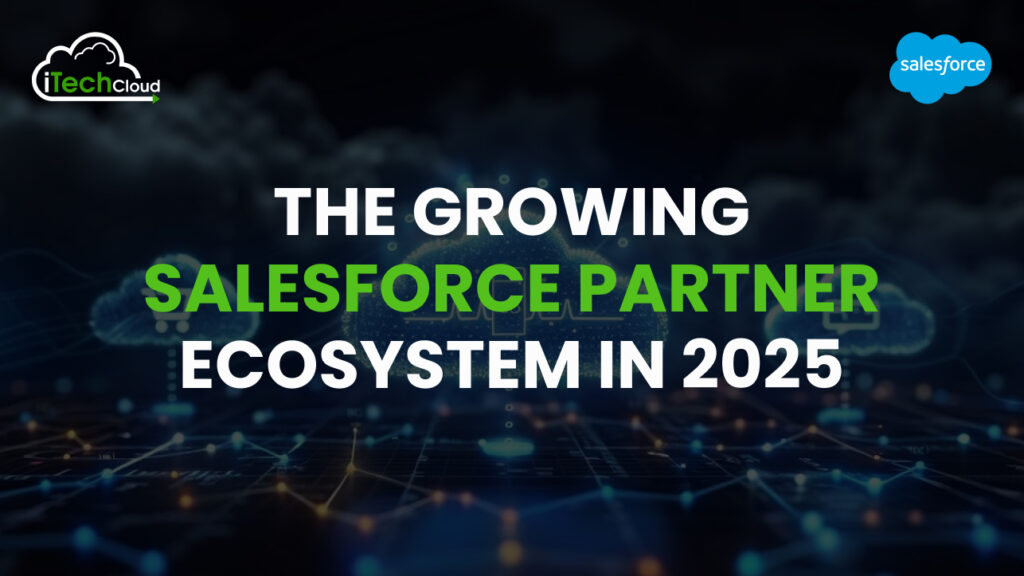The Growing Salesforce Partner Ecosystem in 2025

Salesforce, the world’s leading customer relationship management (CRM) platform, has continuously expanded its ecosystem over the years. In 2025, the Salesforce Partner Ecosystem is more dynamic than ever, with a growing network of consulting firms, independent software vendors (ISVs), system integrators, and service providers contributing to its success. This thriving ecosystem not only drives innovation but also empowers businesses to maximize their Salesforce investments.
Table of Contents
The Evolution of the Salesforce Partner Ecosystem
The Salesforce Partner Ecosystem has evolved significantly since its inception. Initially, partnerships were limited to a handful of consulting firms and technology vendors. However, with Salesforce’s commitment to customer success and innovation, the ecosystem has expanded exponentially.
1. Diverse Partner Categories
The Salesforce Partner Ecosystem consists of various types of partners, each playing a crucial role in driving the platform’s growth and adoption:
1. Consulting Partners:
These firms specialize in implementing and customizing Salesforce solutions for businesses. They help organizations optimize workflows, integrate third-party applications, and provide strategic guidance.
2. Independent Software Vendors (ISVs):
ISVs develop and distribute applications through the Salesforce AppExchange, offering specialized solutions that enhance the CRM’s capabilities.
3. Managed Service Providers (MSPs):
These partners provide ongoing support, maintenance, and optimization services to ensure long-term success for Salesforce users.
4. System Integrators (SIs):
SIs focus on large-scale digital transformations, integrating Salesforce with complex enterprise architectures.
5. Resellers and Training Partners:
Some partners focus on reselling Salesforce products and offering professional training services to upskill businesses and individuals.
Key Trends Shaping the Salesforce Partner Ecosystem in 2025
As Salesforce continues to innovate, its partner ecosystem adapts to new industry trends and emerging technologies. Here are some of the major trends influencing the landscape in 2025:
1. AI and Automation Integration
Artificial intelligence (AI) is a major driver of digital transformation in 2025, and Salesforce partners are leveraging AI-driven tools like Einstein GPT to provide intelligent automation and predictive analytics. Consulting partners are using AI to optimize customer journeys, while ISVs are developing AI-powered apps that enhance decision-making processes.
2. Hyper-Personalization with Data-Driven Insights
With Salesforce’s advancements in data analytics and Customer Data Platforms (CDPs), partners are helping businesses leverage real-time insights to deliver hyper-personalized experiences. This includes personalized marketing campaigns, tailored customer interactions, and data-driven sales strategies.
3. Industry-Specific Solutions
Salesforce continues to expand its Industry Cloud offerings, and partners are developing niche solutions tailored to specific industries like healthcare, finance, manufacturing, and retail. These solutions are designed to address unique industry challenges while ensuring regulatory compliance.
4. Low-Code and No-Code Development
The demand for rapid application development has increased, and Salesforce’s low-code/no-code tools are enabling partners to build and deploy applications faster. This has led to a surge in ISVs creating innovative solutions without requiring extensive coding expertise.
5. Expansion of Salesforce AppExchange
AppExchange, Salesforce’s marketplace for third-party applications, has witnessed exponential growth. More ISVs are launching apps that cater to specific business needs, and consulting partners are integrating these solutions into their service offerings to enhance overall customer success.
6. Sustainability and Ethical AI
Many Salesforce partners are focusing on building solutions that promote environmental, social, and governance (ESG) initiatives. Additionally, ethical AI is a priority, ensuring that automated decision-making processes remain fair and transparent.
7. Rise of Partner-Led Digital Transformation
Companies are increasingly relying on Salesforce partners for complete digital transformation strategies rather than just CRM implementation. Partners are providing end-to-end consulting, from business process optimization to cloud migration and AI adoption.
The Role of Salesforce in Strengthening the Ecosystem
Salesforce plays an active role in fostering the growth of its partner ecosystem by offering numerous resources and initiatives to support partner success.
1. Salesforce Partner Program Enhancements
Salesforce continuously refines its partner programs to provide better incentives, enablement tools, and certifications. In 2025, the company has introduced advanced partner tiers, allowing high-performing partners to access exclusive benefits, including early access to new features and co-marketing opportunities.
2. Training and Certification Expansion
Salesforce’s focus on skill development has led to an expansion of Trailhead, its online learning platform. New certifications and training modules help partners stay updated with the latest innovations, ensuring they can deliver maximum value to customers.
3. Improved Collaboration and Networking
Events like Dreamforce, Salesforce World Tour, and virtual partner summits provide opportunities for networking, collaboration, and knowledge sharing among ecosystem participants. Salesforce also facilitates partner collaboration through its Partner Community, where businesses can exchange insights and best practices.
4. Incentives for Innovation
Salesforce actively encourages partners to develop cutting-edge solutions by offering funding, grants, and investment programs. Salesforce Ventures continues to invest in promising ISVs, ensuring continuous innovation within the ecosystem.
Challenges and Opportunities for Salesforce Partners
While the Salesforce Partner Ecosystem offers immense growth potential, partners must navigate certain challenges to remain competitive.
1. Increased Competition
As more companies enter the Salesforce ecosystem, competition among partners has intensified. To differentiate themselves, partners must focus on specialization, superior customer service, and innovative solutions.
2. Keeping Up with Rapid Technological Advancements
With Salesforce constantly evolving, partners must invest in continuous learning to stay ahead. This includes adopting AI, automation, and emerging cloud technologies.
3. Navigating Customer Expectations
Customers demand seamless, end-to-end experiences, making it essential for partners to adopt a customer-centric approach. Building long-term relationships and providing value-driven solutions will be key to sustained success.
4. Global Expansion Opportunities
Salesforce’s global reach provides opportunities for partners to expand into new markets. Localization of services, multilingual support, and compliance with regional regulations will be crucial for partners looking to scale internationally.
Future Outlook: What’s Next for the Salesforce Partner Ecosystem?
The Salesforce Partner Ecosystem is evolving rapidly, driven by advancements in AI, industry-specific solutions, and increased demand for automation. Here’s a detailed look at what’s next:
1. AI & Automation (Einstein GPT & AI Cloud)
Salesforce is enhancing AI-driven solutions, integrating Einstein GPT and AI Cloud to provide predictive analytics, automation, and customer insights. Partners must adopt AI-powered tools to stay competitive.
2. Industry-Specific Cloud Solutions
Salesforce’s Industry Clouds (e.g., Financial Services, Healthcare, Retail) are expanding. Partners specializing in these verticals will see increased opportunities.
3. Customer Data & Personalization (Customer 360 & CDP)
The demand for real-time, data-driven personalization is growing. Customer Data Platforms (CDPs) will help businesses enhance customer engagement.
4. Low-Code & No-Code Development
Salesforce is promoting low-code/no-code solutions like Salesforce Flow and MuleSoft Composer to speed up development. Partners should embrace these tools to deliver fast and scalable solutions.
5. AppExchange & ISV Growth
The AppExchange marketplace is expanding, creating opportunities for Independent Software Vendors (ISVs) to develop niche applications. Optimizing apps for AppExchange SEO will be key.
6. Rise of Managed Services & Ongoing Support
Organizations are shifting from one-time Salesforce implementations to ongoing managed services for continuous support, optimization, and upgrades.
7. Sustainability & Net Zero Cloud
Salesforce’s commitment to sustainability and Net Zero Cloud is driving interest in carbon tracking and ESG compliance solutions, opening a new niche for partners.
8. Global Expansion & Localization
Salesforce is expanding in APAC, LATAM, and the Middle East. Partners with localization expertise and regional presence will have a competitive edge.
9. Cybersecurity & Compliance
With increasing data privacy regulations (GDPR, CCPA, HIPAA), Salesforce partners must ensure secure, compliant implementations.
10. Integrations with Third-Party Apps
Salesforce is strengthening integrations with cloud platforms (AWS, Azure, GCP) and productivity tools (Slack, Teams). Partners must develop expertise in cross-platform integrations.
Conclusion:
The Salesforce Partner Ecosystem in 2025 is a powerhouse of innovation, collaboration, and growth. With AI-driven advancements, industry-specific solutions, and a focus on hyper-personalization, partners are playing a pivotal role in transforming businesses worldwide. While challenges exist, the opportunities for growth and success within the ecosystem are boundless. By staying agile, investing in skill development, and embracing technological advancements, Salesforce partners can continue to thrive and drive meaningful customer outcomes in the years to come.

